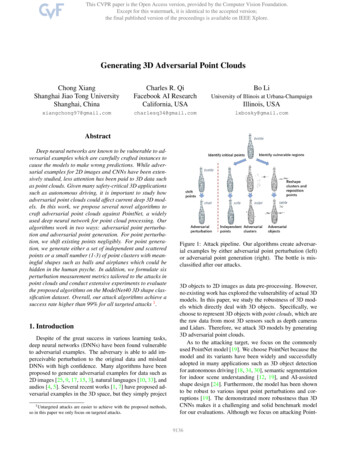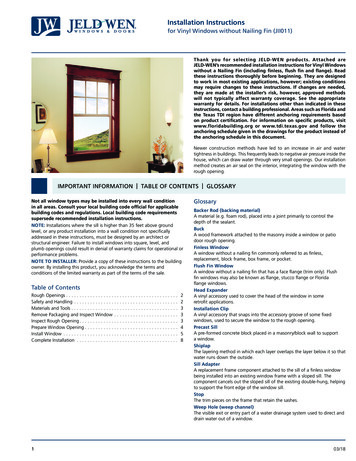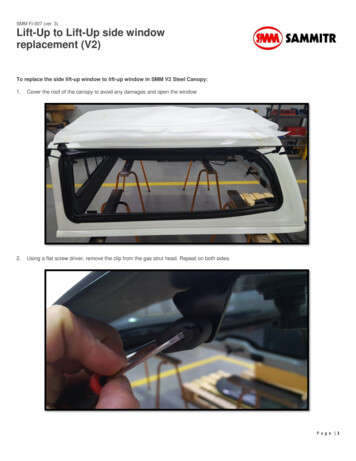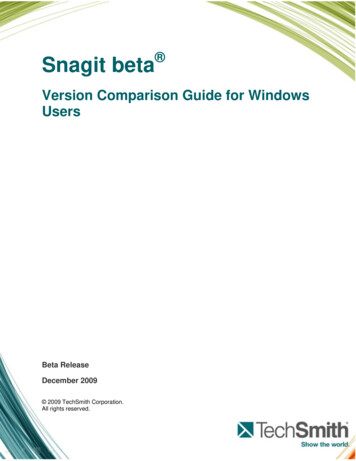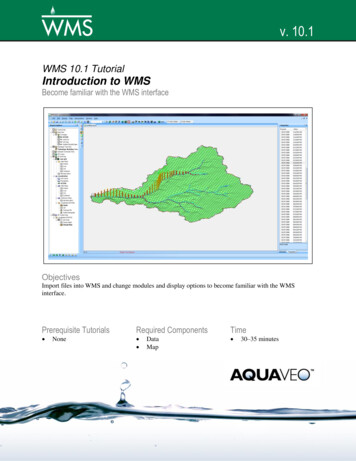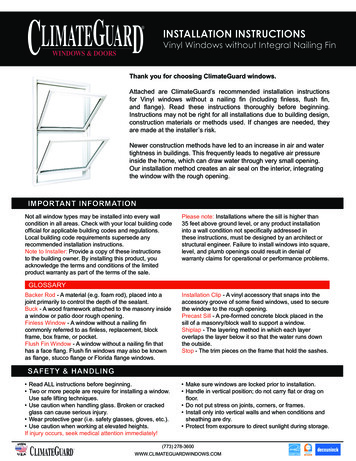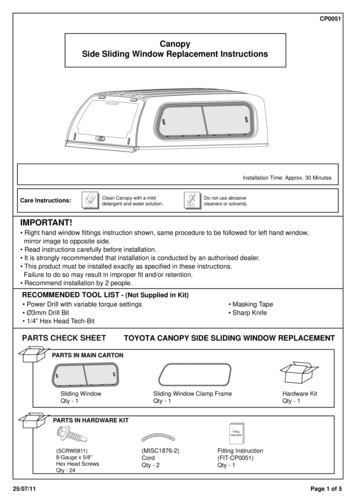
Transcription
The Clouds OutsideMy WindowNational Weather ServiceNOAA
Updated 10/2017
The Clouds Outside My WindowWritten and illustrated byJohn JenseniusMy windowWith help from Owlie Skywarn1
The Clouds OutsideMy WindowWhether I’m outdoors or just looking outside, I like toobserve the clouds. Each cloud is different and has adifferent story to tell. In this book, I’ll explain some ofthe basic cloud types and show you some of theclouds I’ve observed outside my window at theNational Weather Service Office in Gray, Maine.I hope this book will encourage you to observe thesky. You may want to take pictures outside your homeor school and make a book of your own. If you do, letme know, so I can see the clouds outside yourwindow.2-- John JenseniusMeteorologistNational Weather Service
A Look Out My WindowHere’s a look out my window. My office is locatedacross the street from the Pineland Farms EquestrianCenter which you’ll see in many of the cloud pictures.(The black silhouette of the hawk keeps birds fromflying into my reflective windows)3
What are cloudsmade of ?High in the atmosphere where temperatures are very,very cold, most clouds are made of tiny ice crystals.Closer to the ground, the clouds that we see are madeof tiny water droplets.4
How do cloudsform?In general, there are two ways clouds form.In both cases, though, the clouds formbecause the air is cooling.In the atmosphere, rising air cools andsinking air warms. In most cases, the cloudsthat you see are caused by rising air.5
How do cloudsform?Clouds can also form when the air getscolder for other reasons. This can happenovernight when the air is cooling, or whenwarm air moves over a cold lake or a snowcovered surface.6
How are cloudsnamed?Clouds are classified basedon how high they are in thesky, whether they are madeup of tiny water droplets orice crystals, their generalappearance, and whetherthey are producingprecipitation.On the next few pages, I’llexplain some of the basicterminology used toclassify clouds.7
How are cloudsnamed?Puffy clouds are called cumulus or have theprefix “cumulo.”Clouds that form a layer are called stratus orhave the prefix “strato.”Clouds that are made up of ice crystals arecalled cirrus or have the prefix “cirro.”Clouds that produce precipitation are callednimbus or have the prefix “nimbo.”8
How are cloudsnamed?We often need to combine the various cloudterms to accurately describe the clouds we see.For example, puffy clouds are called cumulus;however, if the cumulus clouds form a layer, theyare called stratocumulus.If those puffy cumulusclouds grow upward highinto the sky and producerain, they are calledcumulonimbus clouds.9
Types of Low CloudsLOW10StratocumulusCumulusStratus
Types of Low CloudsStratusStratus clouds often form a blanket of low clouds nearthe ground. They give the sky a dull, gray appearance.11
Types of Low CloudsStratus - Fog12When stratus clouds form at the ground, wecall it fog. If you’ve ever been in fog, you’vebeen inside a stratus cloud.
Types of Low CloudsNimbostratusThese stratus clouds are producing rain. Whenrain falls from stratus clouds, the clouds arecalled nimbostratus clouds.13
Types of Low CloudsStratus – Ground Fog14Sometimes on clear nights, a thin layer of fogforms in the air just above the ground. We callthis ground fog. If you can look over the top ofthe fog, you’re above a cloud.
Types of Low CloudsCumulusThese puffy, low clouds are cumulus clouds. Morespecifically, they are called cumulus humulus clouds.They have distinct bottoms and edges and often formon sunny days as air rises in the atmosphere.15
Types of Low CloudsCumulus16These low clouds are also cumulus clouds. Inthis case, they are called cumulus fractus andhave rough edges, look darker, and usuallyform on sunny, windy days.
Types of Low CloudsStratocumulusWhen cumulus clouds form a layer, we callthem stratocumulus clouds. Because thereare breaks between the clouds, we would saythis is a broken layer of stratocumulus.17
Types of Middle CloudsMIDDLE18AltocumulusAltostratus
Types of Middle CloudsAltocumulusThese puffy clouds are also cumulus clouds.However, because they are at mid-levels in thesky, we call them altocumulus clouds.19
Types of Middle CloudsAltocumulus20Altocumulus clouds early on a summermorning could be a clue that there might bethunderstorms later in the day.
Types of Middle CloudsAltostratusThese mid-level clouds are forming a layer across thesky and are called altostratus clouds. Often, you cansee the dim sunshine through altostratus clouds.21
Types of High CloudsHIGH22CirrusCirrostratusCirrocumulus
Types of High CloudsCirrusThese wispy, high clouds are cirrus clouds. Cirrusclouds are made up of tiny ice crystals. Theysometimes resemble the tails of horses.23
Types of High CloudsCirrus24Cirrus clouds are caused by moisture high up in theatmosphere. Their stretched appearance is due to thestrong winds at those levels.
High Clouds – CirrostratusCirrus clouds that have formed a layer are calledcirrostratus clouds. Sometimes cirrostratus cloudscause a halo around the sun or moon, which can bean indication of an approaching storm.25
High Clouds – Cirrocumulus26Sometimes puffy cumulus clouds form high in theatmosphere. These are called cirrocumulus cloudsand are often most visible at sunrise and sunset.
High Clouds – ContrailsJets can also cause cirrus clouds to form. Theexhaust from the jet engines adds moisture to the airand, under certain conditions, that moisture will formstreaks of ice crystals that we call contrails.27
//////////////////////////////////////////////
Vertically-Developed CloudsCumulonimbusWhen cumulus clouds grow high into the atmosphere,they can produce, lightning, thunder and heavy rain.We call thunderstorm clouds cumulonimbus clouds.29
ColorsIn The Sky30
Colors In The SkySunlight is made up of alldifferent colors of light.Some particles in theatmosphere, such asraindrops and ice crystals,act as prisms and separatethe sun’s light into thevarious colors.Other particles causecertain colored light to bescattered in many differentdirections.31
Why is the sky blue?32When sunlight strikes tiny particles high in the sky,the blue portion of the sun’s light is scattered in alldirections. Because we see the blue light that isscattered toward us from all over the sky, the skylooks blue.
Sunrise ColorsSunrises and sunsets are red, orange, and yellow for thesame reason that the sky is blue. Because the sun’s lightmust travel through more atmosphere at sunrise andsunset, the violet, blue, and green light gets scattered inother directions by particles in the atmosphere, leaving33only the red, orange and yellow light.
Sunrise Colors34Sometimes, high- and mid-level clouds reflect theyellow, orange, and red light from the sun atsunrise or sunset.
Sunset ColorsClouds at sunset are colored for the same reason as theyare at sunrise. Beautiful sunsets often occur when the skyto the west is clearing. In this case, there were clouds35overhead and rain (and a rainbow) just to the east.
Rainbows36Rainbows are caused when raindrops act like littleprisms and separate the sun’s light into the variouscolors that we see as a rainbow. For the main rainbow,the red is on the outside, followed by orange, yellow,green, and blue, indigo, and violet (if visible).
RainbowsIn some cases, the raindrops can cause asecondary rainbow. In this case, the secondaryrainbow is barely visible. The colors are reversedfor secondary rainbows, and the sky betweenrainbows is darker than either side.37
Sundogs38Ice crystals can also act as prisms to separate the sun’slight. In this case, ice crystals have created a sundog inthe sky. Sundogs can occur on one or both sides of thesun when the sun is near sunrise or sunset.
SundogsIf we take a closer look, we see that the red light isclosest to the sun followed by orange, yellow,green, blue, indigo, and violet.39
Iridescence40Thin clouds composed of tiny water droplets or icecrystals can also cause iridescence. This typicallyoccurs near the sun and is often difficult to see.
Now It’s Your Turn !So, that’s a quick lookat some of the cloudsand colorful skiesoutside my windowduring this past year.I’d like to see the cloudsoutside your window.If you make a book ofthe clouds outside yourwindow and post it onthe web, please let meknow and send me alink!If you have any comments or suggestions, please email:John.Jensenius@noaa.gov41
More InformationNWS Jetstream Online School for Weather (Clouds)https://www.weather.gov/jetstream/clouds introNOAA/NASA Cloud Charthttps://www.weather.gov/media/owlie/cloud chart.pdfThe GLOBE Program – Clouds Story ElementaryGLOBE Clouds en.pdfStudents' Cloud Observations On-Line (S'COOL)http://scool.larc.nasa.govTemplate to create your own MyWindow template.ppt42
The Clouds Outside MyWindowThe End43
National Weather ServiceNational Oceanic and Atmospheric Administration
National Weather ServiceNational Oceanic and Atmospheric Administration
different story to tell. In this book, I’ll explain some of the basic cloud types and show you some of the clouds I’ve observed outside my window at the National Weather Service Office in Gray, Maine. I hope this book will encourage you to observe the sky. You may want to take pictures outside your hom

